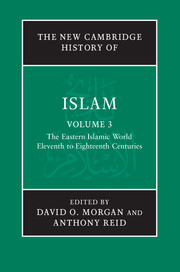Introduction: Islam in a plural Asia
Published online by Cambridge University Press: 28 March 2011
Summary
In writing the history of the Islamic world, there are two expedients which, sooner or later, become impossible to avoid: periodisation and geographical subdivision. These are bound to be, to a greater or lesser extent, arbitrary, but that does not imply that they are necessarily meaningless. It is possible to tell the story of early Islam, the mission of the Prophet Muḥammad, the first Arab Muslim expansion and the Umayyad and ʿAbbāsid caliphates as a single, integrated narrative. There is an essential unity to the historical evolution of the Muslim community, in its first four centuries, which lends itself to such an integrated treatment. From the eleventh century, and increasingly thereafter, this is no longer the case. The political unity represented by the early caliphates is no more. Though caliphs remained important for a time as local rulers, whether in Baghdad, Cairo or al-Andalus, and even more as instruments of legitimisation for Islamic regimes far and wide, real power passed to a multiplicity of sultans, amīrs, maliks and so on. There is nothing very surprising about this. At the point at which this volume commences, the Islamic world stretched uninterruptedly from Spain to Central Asia and northern India. Over the next few centuries it was to spread much further, deeper into India and to western China, and by oceanic routes to East Africa, coastal South Asia, South-East Asia and southern China.
- Type
- Chapter
- Information
- The New Cambridge History of Islam , pp. 1 - 18Publisher: Cambridge University PressPrint publication year: 2010

